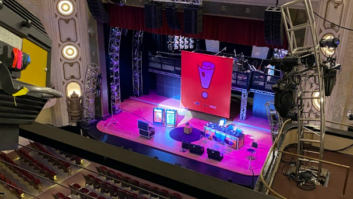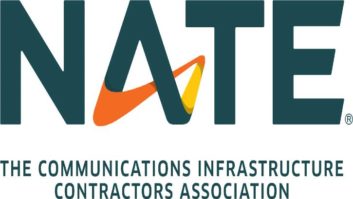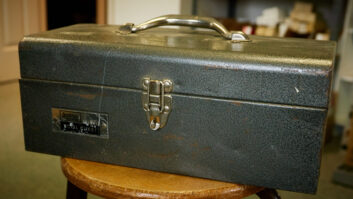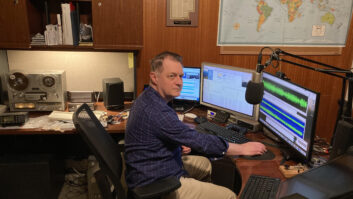
Fig. 1: Rich Hill used an old beacon assembly to drive home a point to his air talent. Engineer Stu Tell writes about a lesson he learned regarding open fuses. This was perhaps 20 years ago — but the lesson is just as good today.
He was asked to look at an old Gates 20H3 that suddenly wouldn’t make full power, though the plate voltage was fine. That transmitter didn’t have a lot of inter-stage metering; so after checking many things, he changed out the drivers. Nothing seemed to solve the problem.
Stu decided to check the three-phase power voltage to the small cartridge fuses that fed the screen supply. Measuring phase to phase, there was voltage to both the line and the load sides of the fuses. OK here.
Eventually Stu gave up and decided to let the group CE fix the problem. Unfortunately, he’d trusted Stu’s diagnostic skills a little too much, and now spent much time looking into other things.
Eventually he pulled the three cartridge fuses for the screen supply and ohmed them out. You guessed it: One of the fuses was open.
The chief was not very happy with Stu, nor was Stu pleased with himself. Later, when they looked at the schematic, they saw the reason Stu had thought he’d seen 240 V across the load sides of the screen supply fuses. The open fuse leg was getting back feed from the primary windings of the screen supply plate transformer!
Stu writes that had he bothered to just power the box down, pull the fuses out and check them with an ohmmeter, he would have saved a lot of time and trouble.
About this same time, Stu was trying to figure out why a 240 V single-phase blower motor wasn’t working. At the time, he had a bad habit of looking at 240 V by checking for 120 V from each leg to neutral. Wrong!
He finally checked for 240 V into the line side of the fuses and noticed the meter read 0 volts on the load side. Sure enough, if you checked from line to neutral on the open side of the fuse, you would see 120 V on either side due to back feed from the motor windings.
The lesson was learned the hard way: If you are checking for 240, measure it like 240. And, might I add, use an analog voltmeter.

Fig. 2: Enjoy an afternoon of fun at ‘The Price Is Right Live’ at Bally’s Jubilee Theatre. * * *
Decorating your reception area at the station? Citadel’s Rich Hill found a very old tower beacon in a garage at WIOV(FM). The red filter glass inside was broken but the beacon assembly itself was intact. The tower had been replaced in the late 1990s.
The station operations manager told Rich he should leave a burned out tower light bulb to show the staff. He flipped when Rich brought in the entire beacon assembly, seen in Fig. 2. They are big, up close and personal. What a fun way to remind jocks to check the tower lights!
* * *
Radio America’s Alan Peterson writes that Len Watson’s laser-pointer idea for aiming a satellite dish is a pretty sharp one — and a huge improvement over a tip he suggested a good 14 or so years ago.
Al was maintaining a satellite dish that had a tendency to go astray in high winds. To make matters worse, the dish was on the roof of the stations’ building in Harrisburg, Pa.
Waterproof lasers were not as inexpensive or as readily available then, but Alan did spot a water tower down the street with a red beacon light. A short piece of pipe was attached to the dish and used as a “rifle sight,” with the water tower’s red light as the target. As long as he could see the light in the pipe, the dish was aimed properly.
Alan Peterson is assistant chief engineer at the Radio America Network in Washington.
* * *
What are the Web sites that you just can’t live without? Kuala Lumpur’s Paul Sagi sends in the following sites:
www.epanorama.net — A compendium of technical information. Some quick-and-easy circuits, and calculator tools for inductance, capacitance and Ohm’s Law.
www.faradnet.com— A capacitor resource. Everything from capacitor discussion forums to catalogs from capacitor manufacturers can be found at this site. There’s a FaradNet bulletin board, which is a popular spot to have your questions answered by experts.
Got a favorite site? Share it with your fellow broadcast engineers. E-mail the information to me at [email protected].
* * *
Radio broadcasting seems to be the springboard for most everyone in the entertainment industry. That is true for Randy West of “The Price Is Right Live.” He has been an announcer on television game shows since 1990, including as a substitute host on “The Price Is Right.” That experience led to work on the Las Vegas iteration.
Randy’s roots stretch deep into radio, where polished delivery is king. Randy makes it look so easy, but then he had a great mentor, TV’s Johnny Olson. They met in 1971; Johnny provided guidance and support during Randy’s early years of broadcasting. When Olson died in 1985, the family entrusted his mementos, awards and scripts to Randy, who now is in the process of writing a book on Olson’s career, and has a featured tribute on his site www.tvrandywest.com.
Tickets for “The Price Is Right Live” are $49.50. The show is presented at Bally’s Jubilee Theater nearly every day. Reservations are recommended. If you have some time between sessions and the exhibit hall, see the live version of television’s longest-running game show. Check the schedule as some of these afternoon shows are sold out.
Who knows — Randy may be calling your name to “Come on down!”
John Bisset has worked as a chief engineer and contract engineer for nearly 40 years. He is now handling international sales for Europe and Southern Africa for Nautel. He was SBE’s Educator of the Year for 2006. Reach him at[email protected]. Faxed submissions can be sent to (603) 472-4944.
Submissions for this column are encouraged and qualify for SBE recertification credit.












